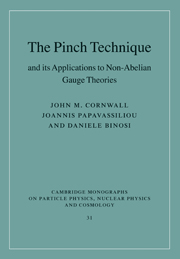Book contents
- Frontmatter
- Contents
- Introduction: Why the pinch technique?
- 1 The pinch technique at one loop
- 2 Advanced pinch technique: Still one loop
- 3 Pinch technique to all orders
- 4 The pinch technique in the Batalin–Vilkovisky framework
- 5 The gauge technique
- 6 Schwinger–Dyson equations in the pinch technique framework
- 7 Nonperturbative gluon mass and quantum solitons
- 8 Nexuses, sphalerons, and fractional topological charge
- 9 A brief summary of d = 3 NAGTs
- 10 The pinch technique for electroweak theory
- 11 Other applications of the pinch technique
- Appendix: Feynman rules
- Index
2 - Advanced pinch technique: Still one loop
Published online by Cambridge University Press: 04 February 2011
- Frontmatter
- Contents
- Introduction: Why the pinch technique?
- 1 The pinch technique at one loop
- 2 Advanced pinch technique: Still one loop
- 3 Pinch technique to all orders
- 4 The pinch technique in the Batalin–Vilkovisky framework
- 5 The gauge technique
- 6 Schwinger–Dyson equations in the pinch technique framework
- 7 Nonperturbative gluon mass and quantum solitons
- 8 Nexuses, sphalerons, and fractional topological charge
- 9 A brief summary of d = 3 NAGTs
- 10 The pinch technique for electroweak theory
- 11 Other applications of the pinch technique
- Appendix: Feynman rules
- Index
Summary
In this chapter, we study several more advanced aspects of the pinch technique (PT), still sticking to one-loop processes, mostly in perturbation theory but with some discussion of one-dressed-loop effects related to gluon mass generation. One of these applications of the pinch technique also has nonperturbative consequences, coming from the invocation of a gauge-field condensate; it allows us to conclude, as we show in this chapter, that the dynamical gauge-boson mass in QCD vanishes like q−2, modulo logarithms, at large momentum. Finally, we introduce one of the main themes of the rest of the book: the pinch technique is realized to all orders by calculating conventional Feynman graphs in the background-field Feynman gauge. The subjects covered include the following:
The pinch technique and the operator product expansion (OPE) at one loop, where we see how only gauge-invariant condensates such as 〈Tr GµνGµν〉 arise in PT Green's functions and how this condensate governs the vanishing at large momentum of dynamically generated gauge-boson mass in QCD.
Uses of the pinch technique in studying gauge-boson mass generation, both dynamic in QCD (no symmetry breaking, whether by Higgs–Kibble fields or other mechanisms) and with spontaneous symmetry breaking.
The background field method and the effective action.
The one-loop equivalence between the pinch technique and the background field method in the Feynman gauge.
The pinch technique and the operator product expansion: Running mass and condensates
As mentioned more than once, the pinch technique is essential to unveiling the nonperturbative effects that are vital in understanding confinement in QCD.
- Type
- Chapter
- Information
- Publisher: Cambridge University PressPrint publication year: 2010



